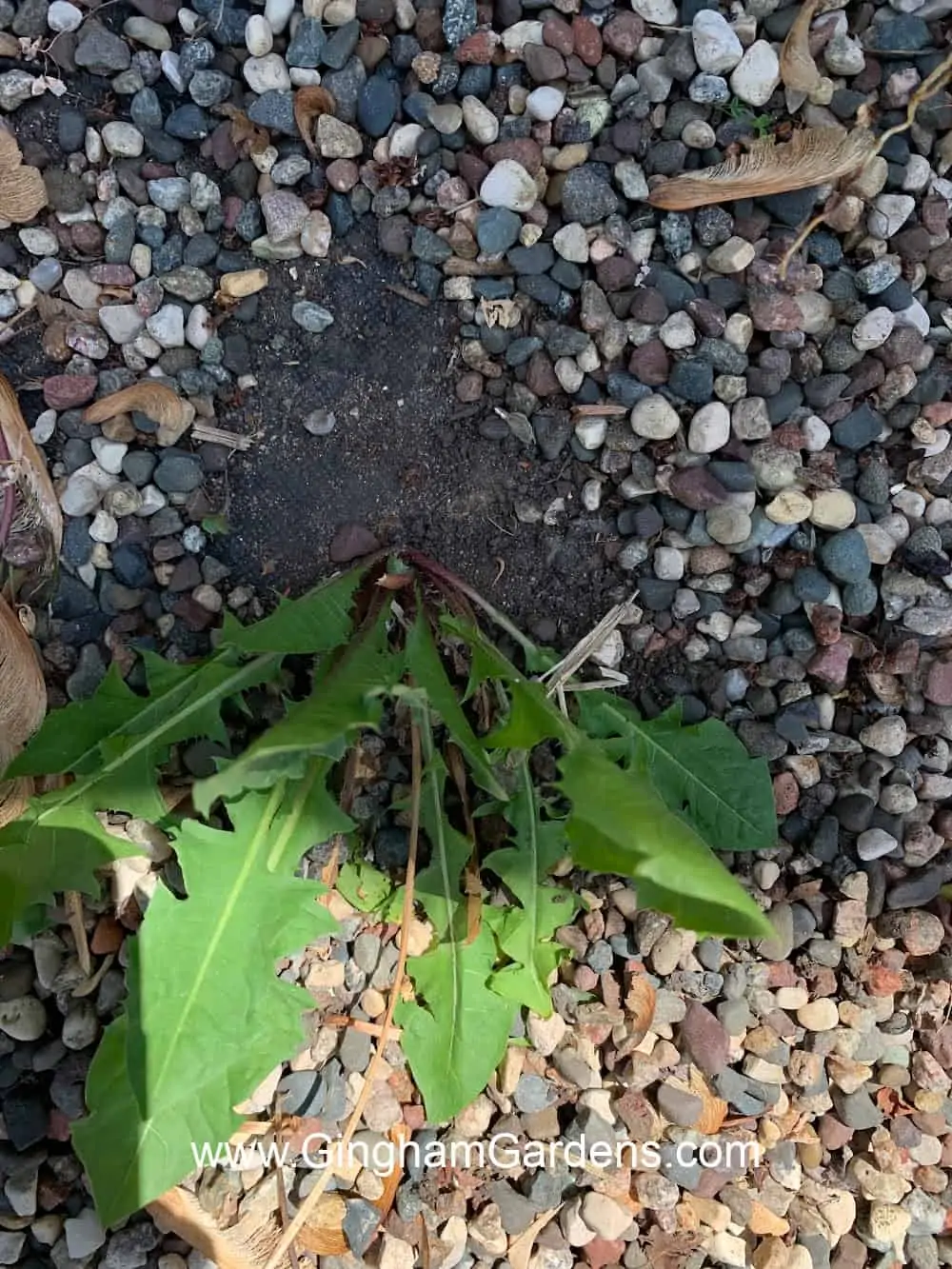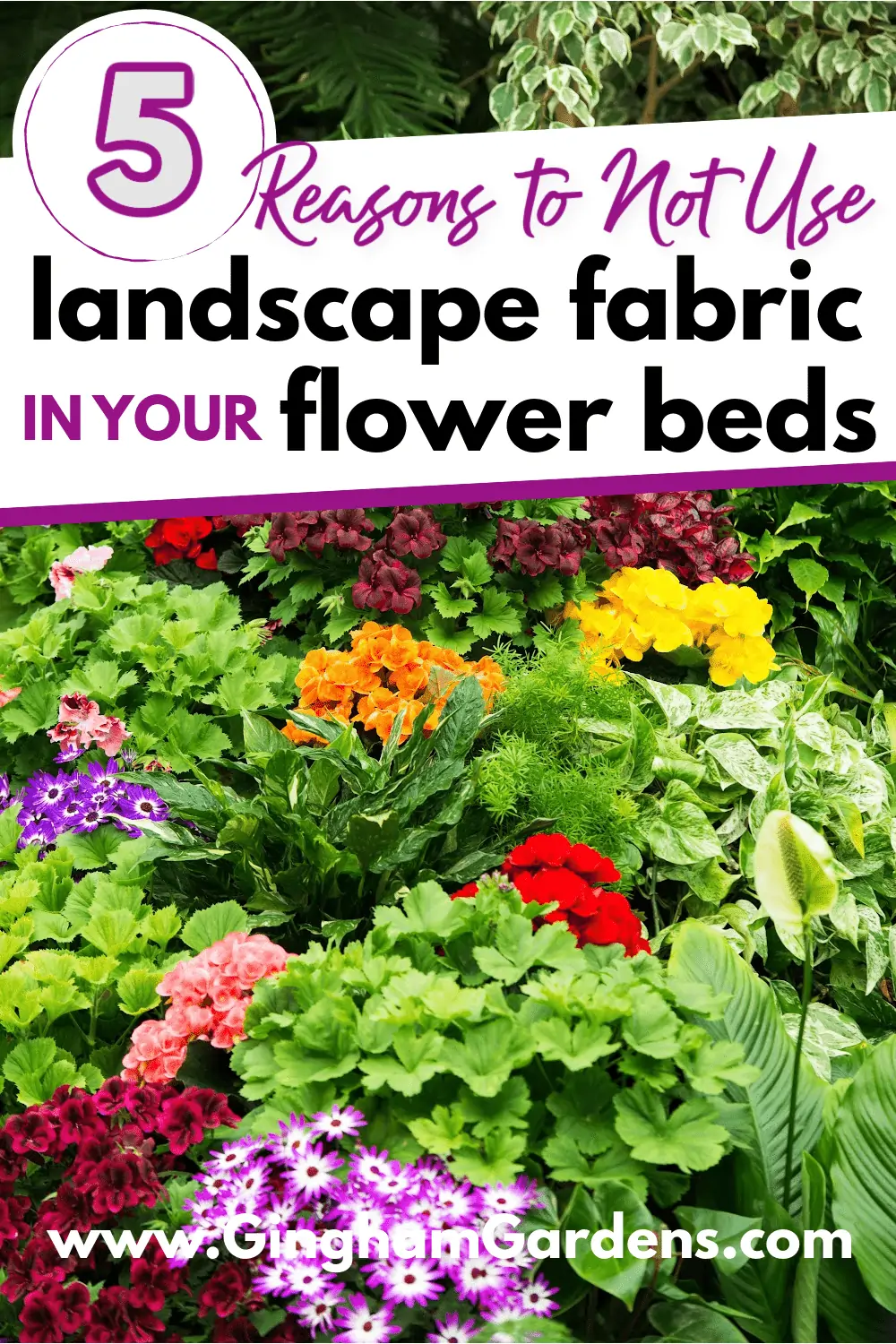5 Reasons Not to Use Landscape Fabric in a Flower Bed
Sometimes homeowners, or even gardeners, want a beautiful landscape, but don’t want the work that goes along with it. I totally get it, if gardening isn’t your thing, or you simply don’t have the time, I realize that you’re looking for low maintenance. Ask yourself these questions when considering whether or not to use landscape fabric in a flower bed or your landscape:
- Are you a gardener? Or, do you just want to create some curb appeal?
- Do you want to grow perennial or annual flowers?
- What are you trying to achieve by using landscape fabric?
This post contains affiliate links. If you click on
one of the links and make a purchase,
I may receive a small commission at no additional cost to you.
See full disclosure here.
Reason #1 Not to Use Landscape Fabric – It does not suppress weeds!
Landscape fabric, or weed control fabric, is typically used as a way to suppress weed growth. But, here’s the thing– it simply does not work! It does not suppress weeds! Yes, maybe the first few years, you will notice fewer weeds. Eventually organic matter will accumulate on top of the fabric (even if the fabric is covered with river rock or wood chips) and it creates the perfect atmosphere for weed seeds to germinate.
Also, weeds (especially dandelions) will eventually grow through the landscape fabric (see example below), both from the bottom and top. Weeding an area that has landscape fabric is a complete pain in the you-know-what. The roots of the weeds grow through the landscape fabric making it difficult to pull them.
Think about how many times you see weeds growing on gravel or in concrete cracks. If weeds grow in those places, landscape fabric will not stop them.
Reason #2 Not to Use Landscape Fabric in a Flower Bed – Difficult Planting
Landscape cloth is not conducive to planting new plants, transplanting or dividing existing plants. An area that has landscape fabric is a nightmare to plant in. You have to cut through the fabric in order to place new plants.
Have you ever tried to transplant a perennial that is growing in a bed where landscape fabric was used? The roots of some perennials can become entwined in the fabric. Trust me when I say, it’s no fun!
Reason #3 Not to Use Landscape Fabric in Flower Gardens – Soil and Plant Health
The key to growing healthy plants starts with healthy soil. Building healthy soil is not a one and done deal, it’s an ongoing process.
Healthy soil is rich in organic materials, retains moisture without being waterlogged and allows proper airflow to the roots or your plants. Landscape fabric prevents the ongoing development of healthy soil. With landscape fabric, there is simply no way to amend the soil it covers.
When landscape fabric is involved, good organic matter, or even adequate moisture, cannot reach the root of the plants. Most landscape fabric is a mesh material which is designed to allow moisture and air through the woven fabric.
Many advocates of using landscape fabric will say it helps to retain soil moisture. In reality that mesh becomes clogged with soil and organic matter over time and becomes less penetrable and necessary water and air cannot reach plant roots.
Earthworms and other living organisms are an important part of soil health. Their job is to aerate and fertilize soil. Landscape fabric chokes out the vital air they need, so many of the tiny living things (called microbes) and earthworms can’t do their thing under landscape fabric.
Can perennials grow through landscape fabric? Yes, they can. But, landscape fabric may constrict the growth of plants. Not all, but many perennial plants will be inhibited from growing larger over time, because they have no room to expand.
While we’re on the subject of soil and plant health, let’s sidestep here and talk a little about river rocks. Many times landscape rocks are added to landscaping fabric and that causes even more issues for the poor plants. Heat can be intense when using rocks and can bake the roots of a plant. Rocks are heavy and heat up, this is severely stressful to most plants and their root systems.

The 4th and 5th Reasons – Maintenance & Cost
The reason most landscape professionals promote the use of weed barrier fabric in the first place is that it makes landscape beds aesthetically pleasing and it’s low maintenance. Again, yes the newly landscaped area may look great for a couple of years, but eventually weeds will start growing. Now, the beautiful landscaping that you spent so much money on is no longer low or no maintenance. Many then resort to using a weed killer and that’s never a good idea.
If you decide to add landscape fabric to a garden area yourself, it’s not an easy job, nor is it inexpensive. You will need to do some research and find the best landscape fabric and how to install it properly. Then the whole ordeal of installing it, getting the fabric to lay flat and using the proper garden staples to hold it in place, is not an easy DIY job.
Also, for water to run through it properly, landscape fabric must be laid perfectly flat, which is nearly impossible. All is takes is heavy rains for you to see where your landscape fabric is not flat. The rain water will pool in that area causing a myriad of other problems.
Most of all, if you’ve ever had to remove old landscape fabric from flower gardens, you will immediately know why to never use it. Over the past several years, I have been renovating old gardens and one of the worst was a flower garden where the previous owners had used a combination of black plastic and landscape fabric. On top of that was about a 12″ layer of river rock and on top of that was several inches of organic materials including mulch. It was a lot of hard work and took a long time to clean the old bed out, but I’m happy to report that the effort and money spent was worth it. Even after all the work, when planting new plants, I still run into river rock and pieces of fabric and plastic.
A good quality landscape fabric is expensive. Weigh that with the time of installing it properly and then the time to remove it in a few years when you figure out that it doesn’t work, and that, in and of itself, is a good enough reason not to use landscape fabric in the first place.
Here are my picks for weed control in your gardens:
Alternatives to Using Landscape Fabric in Your Garden Bed
Some will say use black plastic as an alternative to landscape fabric, because weeds can’t grow through plastic. If you have any concern for your gardens and the environment at all, do not use plastic as a weed barrier. Rain water cannot penetrate plastic, nor can any organic matter.
Plastic does not allow water or air through, plant roots need both. If you place plastic or landscape fabric under mulch, you will find your plant’s roots all directly under the plastic or fabric, at the soil surface, as they reach for water and air.
The best weed barriers in your flower beds are organic mulches, which help prevent light from reaching weed seeds while helping to retain soil moisture and gradually breaking down to help build healthy soil. Mulch also provides a habitat for many pollinators. A heavy layer of mulch greatly limits the number of weeds in my gardens and I believe it’s the best choice for weed reduction.
Another better option for using landscape cloth is planting ground cover plants. Ground cover will do a good job to suppress weeds and it’s also a pretty alternative.
Newspaper or card board are good biodegradable alternatives to weed cloth. Adding 3 inches or more of a good shredded wood mulch on top of it is a great way to suppress weeds. Newspaper and cardboard will break down over the growing season and if need be they can easily be removed.
Dried, untreated grass clippings are another good, biodegradable alternative to garden fabric. I like to use grass clippings around my plants in my raised veggie beds. The clippings form a mat and work wonderfully for weed suppression.
Good Places to Use Landscape Fabric
A proper use of landscape fabric is for pathways. We have it under pea gravel paths and it does help with weed reduction. The picture above shows one of our garden paths where we used landscape fabric under the pea gravel. Although there are still weeds that pop up, there aren’t as many. Plus, we don’t have to worry about the health of the soil in these areas.
We also utilized landscape fabric under a large playground area in our backyard. We also cover the fabric with pea gravel in this area.
Landscaping fabric also works well between rows of a vegetable garden, or cut flower garden. Or, even around raised garden beds, where nothing will be planted.
Do Not Use Landscape Fabric in Your Flower Gardens
I think landscape fabric could offer some weed reduction, particularly in the first few years. But in the long-term, it’s definitely a negative for soil health, plant health, air and water circulation, etc.
I have taken out old plastic and landscaping fabric as well as rock and the plants explode.
Using landscape fabric creates more work in the long run. First, with the installation. Second, when you’re planting new plants. And, lastly, when you finally realize it simply doesn’t work and you have to pull it all out.
If after reading this article, you’re still considering using landscape fabric in your flower garden, be sure you ask friends and neighbors what experience they’ve had.
Need more help with your flower gardens, check out these articles:
How to Deal With Weeds In Your Garden
Flower Garden Maintenance Tips
Flower Gardening 101
Have you ever had to deal with removing landscape fabric from your gardens or landscaping? Please leave a comment and tell me your experience.
Do you use landscape fabric in your gardens and love it? Likewise, please leave a comment and tell me your experience.
Happy gardening,
Joanna
p.s. Feel free to save the pins below to your favorite gardening board on Pinterest. If you hover in the upper left-hand corner of the picture, you’ll see the little Pinterest icon. Just click it and pin away. There are more pins to share below.
p.p.s I’d love to have you follow Gingham Gardens on Pinterest. Lots of great gardening ideas and tons of eye candy for gardeners. Gingham Gardens is also on Facebook.
Pins to share:





